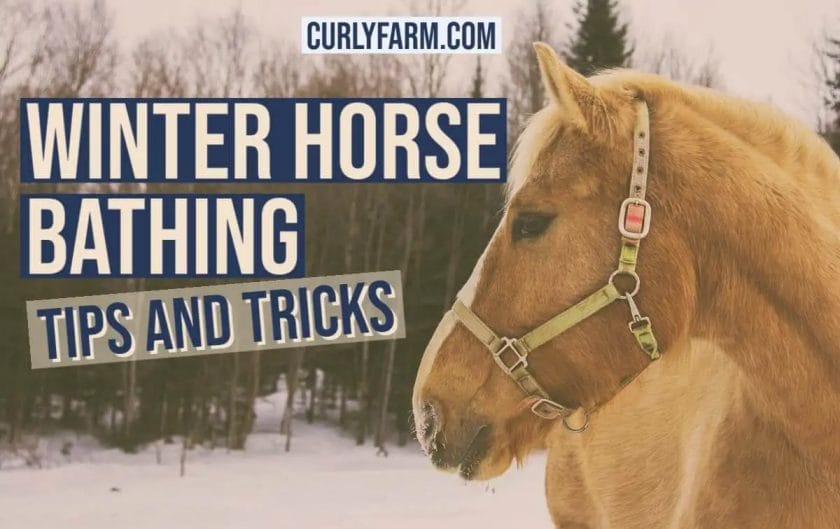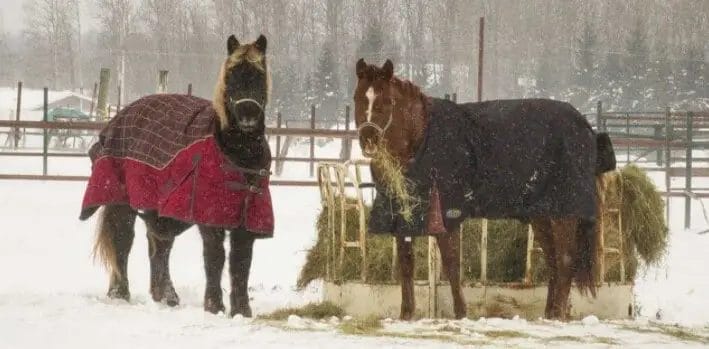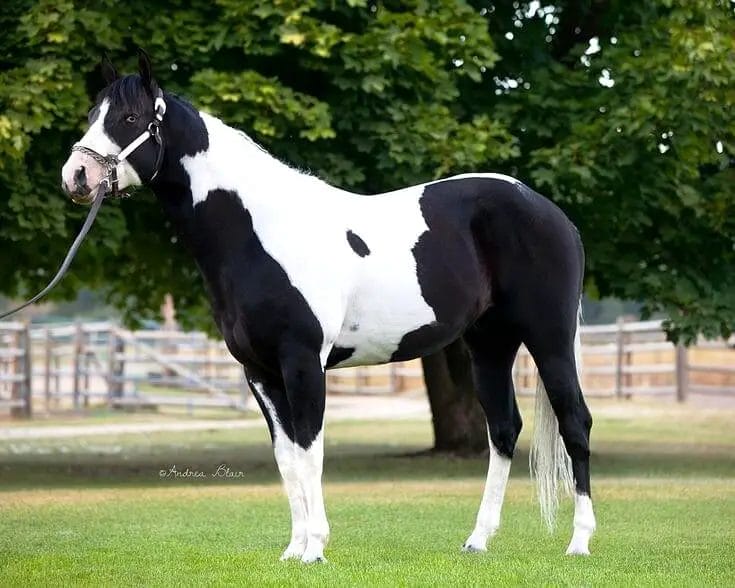Horses are remarkably adaptable to cold weather, but there are certain temperature thresholds to consider when it comes to their well-being. While each horse is unique, it’s generally recommended to bring them indoors if the temperature drops below 10°F (-12°C), particularly if there is wind or rain. This is because extreme cold can lead to hypothermia or frostbite. Ensuring they have access to shelter, fresh water, and adequate nutrition is crucial during colder months to keep them healthy and comfortable.

Factors to Consider when Assessing Cold Weather Tolerance in Horses
When it comes to assessing the cold weather tolerance of horses, there are several important factors that need to be taken into consideration. Horses, like any other animals, have varying degrees of tolerance to cold temperatures. Understanding these factors will help horse owners provide appropriate care and management to ensure the well-being of their equine companions during the colder months.
1. Breed
The breed of the horse plays a significant role in determining its cold weather tolerance. Some breeds, such as the Icelandic horse and the Norwegian Fjord horse, have evolved in harsh climates and are naturally more suited to withstand cold temperatures. These cold-adapted breeds typically have thick, insulating coats and a compact body structure that helps them conserve body heat.
On the other hand, breeds originating from warmer climates, such as Arabian horses, may have a lower tolerance to cold weather. These horses may require additional protection and care to keep them comfortable in chilly conditions.
2. Coat Thickness and Quality
The thickness and quality of a horse’s coat are crucial factors in determining its ability to tolerate cold weather. Horses with thick, dense coats are better equipped to regulate their body temperature in cold conditions by trapping warm air close to their skin. Additionally, a well-groomed and healthy coat helps prevent heat loss and provides natural insulation.
However, not all horses naturally have a thick or high-quality coat. Some breeds or individuals may have thinner coats, which can make them more susceptible to the cold. In such cases, additional protection in the form of blankets or shelters should be provided to keep them warm and prevent any adverse effects of cold exposure.
3. Body Condition and Health
A horse’s overall body condition and health status can greatly impact its ability to tolerate cold weather. Horses that are underweight or have underlying health issues may struggle to maintain their body temperature in cold conditions. Adequate nutrition and regular veterinary care are essential to ensure that horses are in good health and have the necessary energy reserves to cope with the demands of cold weather.
In addition to body condition, horses with certain health conditions, such as arthritis or respiratory disorders, may be more sensitive to the cold. Extra precautions should be taken to provide them with suitable shelter, bedding, and proper care to minimize any discomfort or worsening of their condition.
4. Acclimatization
Acclimatization refers to a horse’s ability to gradually adjust to changes in temperature and weather conditions. Horses that are exposed to colder temperatures over time can develop a better tolerance for cold weather. However, sudden changes in weather, such as a rapid drop in temperature, can pose a challenge to even acclimatized horses.
It is important to monitor and assess a horse’s cold weather tolerance based on its previous exposure and acclimatization level. This can help determine if any additional measures, such as providing extra insulation or limiting outdoor exposure, are necessary to keep the horse comfortable and prevent any adverse effects of extreme cold.
5. Management and Care
The management and care provided to horses during cold weather also play a vital role in their overall cold tolerance. Adequate shelter, such as a well-insulated barn or a suitable outdoor shelter, should be available to protect horses from harsh winds, rain, and snow. Proper ventilation is essential to prevent the build-up of moisture and condensation, which can be detrimental to the horse’s health.
Furthermore, providing horses with access to clean, fresh water at all times is crucial, as dehydration can increase their susceptibility to cold stress. Regular grooming and check-ups by a veterinarian ensure that any potential health issues are addressed promptly and that the horse’s overall well-being is maintained.
Summary
Assessing the cold weather tolerance of horses involves considering various factors such as breed, coat thickness and quality, body condition and health, acclimatization, and management and care. Taking these factors into account will help horse owners make informed decisions and provide the necessary care and protection to ensure their horses stay healthy, comfortable, and safe during the colder months.

Signs of Cold Stress in Horses: What to Look Out For
As horse owners, it is crucial to be aware of the signs of cold stress in horses. Just like humans, horses can also experience discomfort and health issues during cold weather. Being able to recognize these signs will help you take appropriate action to ensure the well-being of your equine companion. In this section, we will discuss the common signs of cold stress in horses that you need to look out for.
1. Shivering
One of the most obvious signs of cold stress in horses is shivering. Shivering is the body’s natural way of generating heat to keep warm. If you notice your horse shivering, it’s a clear indication that they are feeling cold and trying to regulate their body temperature. Keep in mind that shivering alone may not always be a definitive sign of cold stress, as horses can shiver in response to other factors such as pain or anxiety. However, when accompanied by other symptoms, it should be taken seriously.
2. Increased Hair Coat
In order to protect themselves from the cold, horses have the ability to grow a thicker hair coat. This is a natural mechanism that helps them insulate their bodies. If you observe your horse with an unusually thick hair coat or if their coat starts to stand up, it could be a sign of cold stress. Keep in mind that some horse breeds naturally have thicker hair coats, so it’s essential to be familiar with what is normal for your specific horse.
3. Decreased Activity and Lethargy
Cold stress can cause horses to become less active and show signs of lethargy. They may appear dull, uninterested, and lack their usual energy levels. Cold temperatures can make it uncomfortable for horses to move around and engage in their regular activities. If you notice a significant decrease in your horse’s activity level, it could be a sign that they are experiencing cold stress.
4. Loss of Appetite
Horses that are cold-stressed may also experience a loss of appetite. The body’s priority during cold weather is to keep warm, so horses may not feel as inclined to eat. If your horse is refusing food or eating significantly less than usual, it is essential to monitor their condition closely and take appropriate measures to ensure they are getting proper nutrition.
5. Increased Water Consumption
In an effort to keep warm, horses may increase their water consumption during cold weather. Drinking more water helps them maintain hydration and regulate body temperature. If you notice a sudden increase in your horse’s water intake, it could be a sign that they are trying to combat the effects of cold stress. Ensure that fresh, clean water is always available for your horse to prevent dehydration.
6. Huddled Posture
When horses are feeling cold, they may assume a huddled posture to conserve body heat. They may stand with their head down, back hunched, and limbs tight together. This posture helps minimize heat loss from the body. If you observe your horse consistently assuming a huddled posture, it is a clear indication that they are experiencing cold stress.
7. Frostbite
Severe cold stress can lead to frostbite in horses. Frostbite occurs when the tissues of the extremities, such as the ears, tail, and lower limbs, freeze due to prolonged exposure to cold temperatures. Symptoms of frostbite include discoloration, swelling, and the formation of ice crystals on the affected areas. If you notice any signs of frostbite, it is crucial to seek veterinary attention immediately.
8. Poor Body Condition
Cold stress can have a negative impact on a horse’s body condition. Horses that are consistently exposed to cold temperatures without proper protection may experience weight loss and a decline in overall body condition. If you notice a deterioration in your horse’s body condition, it is essential to evaluate their living conditions and make appropriate adjustments.
In summary, being able to recognize the signs of cold stress in horses is vital for their well-being. By observing any of the aforementioned symptoms such as shivering, increased hair coat, decreased activity, loss of appetite, increased water consumption, huddled posture, frostbite, or poor body condition, you can take the necessary steps to ensure your horse stays warm and healthy during cold weather.

Preparing Horse Shelters for Extreme Cold Weather
As the winter season approaches, it is crucial for horse owners to make necessary preparations to ensure the well-being and safety of their animals. Extreme cold weather can pose various risks to horses, including hypothermia, frostbite, and dehydration. By taking proactive measures and making some adjustments to horse shelters, owners can create a more comfortable and protected environment for their equine companions. In this section, we will discuss some essential steps to prepare horse shelters for extreme cold weather.
1. Insulation and Ventilation
Proper insulation is essential to keep the horse shelter warm during freezing temperatures. Insulate the walls and roof of the shelter using materials such as foam insulation, which helps retain heat and prevent drafts. Additionally, ensure adequate ventilation to prevent the buildup of moisture, which can lead to respiratory issues for the horses. Install vents and windows in the shelter to allow for fresh air circulation while maintaining a comfortable temperature.
2. Bedding
Provide sufficient and appropriate bedding to keep the horses warm and insulated from the cold ground. Good choices for bedding include straw, shavings, or specialized bedding materials designed for colder climates. Regularly clean and replenish the bedding to maintain cleanliness and warmth in the shelter.
3. Windbreaks
Construct windbreaks around the horse shelter to minimize the impact of strong winds and create a more sheltered environment. Windbreaks can be made using materials such as solid panels, heavy-duty tarps, or natural barriers like trees or shrubs. Position the windbreaks strategically to block the prevailing winds and create a protected space for the horses.
4. Lighting
Ensure sufficient lighting inside the horse shelter to aid visibility during darker winter months. Proper lighting not only helps horse owners monitor their animals but also promotes a sense of security for the horses. Consider using LED lights that are energy-efficient and provide clear illumination.
5. Water Supply
Prevent the water supply from freezing by using heated water buckets or tank heaters. Horses need access to clean water at all times, even in cold weather, to prevent dehydration. Regularly check the water supply and break any ice that may form on the surface. Ensure that the water source is protected from the elements and insulated to maintain a consistent temperature.
6. Emergency Preparedness
Be prepared for any potential emergencies that may arise during extreme cold weather. Have a backup power source, such as a generator, in case of power outages. Keep emergency supplies on hand, including extra bedding, first aid kits, and additional feed. Develop an emergency plan and communicate it to all involved parties to ensure a swift response in case of any unforeseen circumstances.
7. Regular Maintenance
Regularly inspect the horse shelter and perform necessary maintenance tasks to keep it in good condition. Check for any leaks, damaged insulation, or loose panels that may compromise the shelter’s effectiveness. Clear any debris or snow buildup around the shelter to maintain a safe and accessible environment for the horses.
In summary, preparing horse shelters for extreme cold weather is crucial to ensure the well-being of horses during winter months. By implementing measures such as insulation, proper bedding, windbreaks, lighting, and an unfrozen water supply, owners can create a comfortable and protected space for their equine companions. It is also important to be prepared for emergencies and conduct regular maintenance to keep the shelter in optimal condition. By taking these steps, horse owners can ensure that their horses stay healthy and comfortable throughout the winter season.
Tips for Keeping Horses Comfortable in Chilly Conditions
As winter approaches, it’s important to ensure that your horses are comfortable and well-cared for in chilly conditions. The cold weather can pose various challenges to equine health and well-being. Here are some useful tips to help keep your horses comfortable during the colder months:
1. Provide Adequate Shelter
Having a suitable shelter is crucial for horses to seek refuge from the cold, wind, and precipitation. A sturdy and well-insulated barn or run-in shed can serve as a safe haven for your horses during bad weather. Make sure the shelter is well-ventilated to prevent moisture buildup and keep the air fresh.
2. Use Blankets
Blanketing your horses can provide additional warmth and protection against the cold. Choose blankets that are appropriate for the temperature and weather conditions. Make sure the blankets fit properly, allowing for freedom of movement without causing discomfort or rubbing. Regularly check the blankets for any signs of damage or wear and replace them if necessary.
3. Adjust Feed and Water
In cold weather, horses may require more calories to maintain their body temperature. Ensure that your horses have access to good quality forage and consider increasing their feed rations if necessary. It’s also important to provide fresh, unfrozen water at all times. Consider using heated water buckets or tank heaters to prevent freezing.
4. Maintain Good Hoof Care
Regular hoof care is essential for horses in any season, but it becomes even more crucial during winter. Regularly check your horse’s hooves for any signs of thrush, cracks, or other issues. Ensure proper trimming and consider using hoof boots or pads to provide additional protection against the cold and wet ground.
5. Exercise and Turnout
Regular exercise and turnout are vital for a horse’s physical and mental well-being, even in cold weather. Encourage daily exercise to keep your horses active and maintain their muscle tone. However, be cautious of icy or slippery conditions, and avoid excessive exertion in extreme cold.
6. Additional Bedding
Provide ample bedding in your horse’s stall to help insulate and keep them comfortable. Straw, shavings, or specialized bedding materials can offer additional warmth and cushioning. Regularly clean and replace the bedding to maintain a clean and dry environment.
7. Monitor Body Condition
Regularly assess your horse’s body condition to ensure they are maintaining a healthy weight. Cold weather may increase their energy needs, so adjust their diet accordingly. Pay attention to any changes in appetite, coat condition, or behavior that may indicate health issues.
8. Regular Veterinary Care
Schedule regular check-ups with your veterinarian to address any winter-specific health concerns and ensure your horse is up to date on vaccinations and deworming. Regular dental care is also important to maintain proper chewing and digestion, especially when the availability of fresh grass is limited.
In summary, taking proactive measures to keep your horses comfortable in chilly conditions is crucial for their well-being. Adequate shelter, proper blanketing, adjusted feeding and water, hoof care, exercise, additional bedding, monitoring body condition, and regular veterinary care are all important aspects to consider. By implementing these tips, you can help ensure that your horses stay healthy and content during the winter season.
FAQs
How cold is too cold for horses to be outside?
Generally, horses can tolerate cold temperatures as low as 5°F (-15°C) without any problems. However, factors like wind chill, humidity, and access to shelter can affect their tolerance. It is recommended to provide horses with shelter, blankets, and adequate food and water when temperatures drop below freezing.
Conclusion
In conclusion, determining the ideal temperature for horses to be outside can be challenging. However, it is generally recommended to consider a few factors. Horses are adaptable animals, but extreme cold can pose health risks. When the temperature falls below freezing, it is crucial to provide proper shelter, including wind protection and access to fresh water. Additionally, monitoring the horse’s body condition, behavior, and overall health is essential. Remember, each horse is unique, and it’s important to consider their breed, age, and individual tolerance to cold. Regularly consult with a veterinarian to ensure the well-being of your horses during harsh weather conditions.
